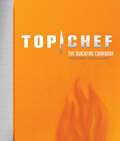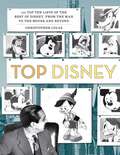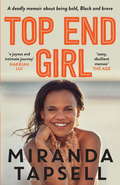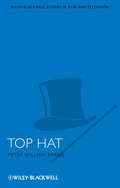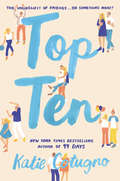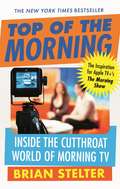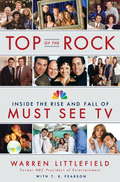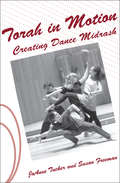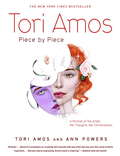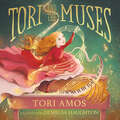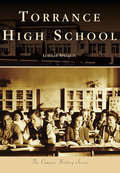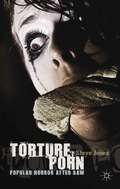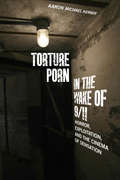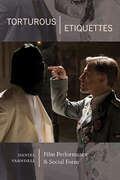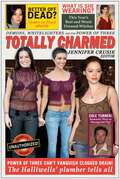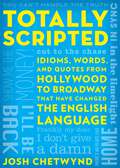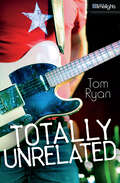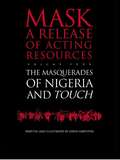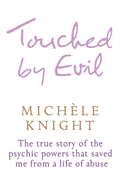- Table View
- List View
Top Chef: The Quickfire Cookbook
by Bravo MediaThe creators of Bravo’s Top Chef share seventy-five Quickfire memorable recipes in this cookbook featuring tips, photos, contestant interviews, and more.The much-anticipated follow-up to the New York Times best-selling Top Chef: The Cookbook is here! Drawing from the first five seasons of the show, Top Chef: The Quickfire Cookbook features 75 of the best recipes—from Spike’s Pizza alla Greek to Stephanie’s Bittersweet Chocolate Cake—culled from the Top Chef Quickfire Challenges. Everything the home chef needs to assemble an impressive meal and channel the energy of the Quickfire kitchen is collected here, including advice on hosting a Quickfire Cocktail Party and staging your own Quickfire Challenges at home. Best of all, this book is spilling over with sidebar material, including tips for home chefs, interviews with contestants, fabulous photos, and fun trivia related to the chefs, dishes, and ingredients that make Top Chef a favorite.
Top Disney: 100 Top Ten Lists of the Best of Disney, from the Man to the Mouse and Beyond
by Christopher LucasThere is not a person on Earth who hasn&’t come into contact with Disney in some way. Whetherseeing a Disney film, hearing a Disney song, recognizing a Disney character or visiting a Disneypark, the company&’s reach is global. Top Disney will collect the best of the best of Disney in a book of lists.From Walt himself and the beginning of his company, to his successors who have broadenedthe reach of the Disney brand well beyond where even Walt could have imagined it, this bookwill cover every aspect of the 93 years of history that Disney has to offer. In it you will findinformation on everything from Oswald the Lucky Rabbit and Queen Elsa, to the billion dollaracquisitions of Marvel and Lucasfilm.
Top End Girl
by Miranda TapsellA deadly memoir about being bold, black and brave in work, life and love'Sharing my story is important ... I think it is true that you don't aspire to be what you cannot see. I would like this book to show you that you can push yourself to do things you never dreamed you would do.'As a young Larrakia Tiwi girl Miranda Tapsell often felt like an outsider. Growing up, she looked for faces like hers on our screens. There weren't many. And too often there was a negative narrative around First Nation lives, and Aboriginal and Torres Strait Islander women especially. As she got older, Miranda stopped expecting others would help change things and set about doing something herself. Combining her pride in her Aboriginality and passion for romantic comedies with her love of Darwin, the Tiwi Islands and the Top End, Miranda co-wrote, produced and starred in the box office hit Top End Wedding.In this engaging memoir, Miranda shares the path she took to acting and how her role in The Sapphires and then in Love Child inspired her to create a film about coming back to family and culture. And, it would turn out, that as she was writing her romantic lead she was also conjuring up some magic that saw a real-life love ignite. This deadly, ballad-loving rom-com nerd also asks us all to open our minds and our hearts to the importance of country and culture, In doing so, Miranda shows us how we will all be richer for it.Funny, wise and thought-provoking, Top End Girl will have you at hello.
Top Hat (Wiley-Blackwell Series in Film and Television #17)
by Peter William EvansTop Hat is the first volume to spotlight this classic Hollywood film, probing the musical genre, notions of romance and subjectivity, as well as the contested relations between the sexes. Offers a detailed analysis of one of Hollywood's greatest musicals, including a comprehensive survey of the film's production, promotion and reception, all measured against the background of 1930s socio-political contexts in the USA Explores the musical genre and questions of (gendered) national identity, romance, subjectivity and the notion of the couple Written in a clear, accessible style, Top Hat probes text and context carefully to appeal to the student and teacher of the musical and of Hollywood film history, as well as the film-loving general reader
Top Ten
by Katie CotugnoThe newest stunning and unforgettable contemporary realistic romance from the New York Times bestselling author of 99 Days, Fireworks, and How to Love. Perfect for fans of Sarah Dessen, Jenny Han, and Morgan Matson. Ryan McCullough and Gabby Hart are the unlikeliest of best friends. Prickly, anxious Gabby would rather do literally anything than go to a party. Ultra-popular Ryan is a hockey star who can get any girl he wants—and frequently does. But somehow their relationship just works; from dorky Monopoly nights to rowdy house parties to the top ten lists they make about everything under the sun.Now, on the night of high school graduation, everything is suddenly changing—in their lives, and in their relationship. As they try to figure out what they mean to each other and where to go from here, they make a final top ten list: this time, counting down the top ten moments of their friendship.
Top of the Morning: Inside the Cutthroat World of Morning TV
by Brian StelterLike Bill Carter chronicling the late night wars in his classic The Late Shift, star New York Times reporter Brian Stelter reveals all the dish and dirt behind the polite smiles and perky demeanors of morning television in his much-anticipated...TOP OF THE MORNINGWhen America wakes up with personable and charming hosts like Matt Lauer, Robin Roberts, and George Stephanopoulos, it's hard to imagine their show bookers having to guard a guest's hotel room all night to prevent rival shows from poaching. But that is just part of the intense reality New York Times staff writer Brian Stelter reveals in TOP OF THE MORNING--a gripping look at the most competitive time slot in television, complete with Machiavellian booking wars and manic behavior by the producers, executives, and stars.Stelter is behind the scenes as Ann Curry replaces Meredith Vieira on the Today show, only to be fired a year later in a fiasco that made national headlines. He's backstage as Good Morning America launches an attack to dethrone Today and end the longest consecutive winning streak in morning television history. And he's there as Roberts is diagnosed with a crippling disease-on what should be the happiest day of her career.Featuring exclusive material about current and past morning stars like Katie Couric and all the major players of the 2000s, TOP OF THE MORNING illuminates what it takes to win the AM, when every single viewer counts, tons of jobs are on the line, and hundreds of millions of dollars are at stake. Among the questions Stelter answers for the first time: Why did NBC really decide to oust Curry from her chair? What was her replacement Savannah Guthrie's reaction? Was Matt Lauer really at fault?So grab a cup of coffee, sit back, and discover the dark side of the sun.
Top of the Morning: The Inspiration for Apple TV's THE MORNING SHOW
by Brian StelterDiscover the cutthroat world behind the polite smiles and perky demeanors of morning news in the book that inspired the Apple TV series starring Reese Witherspoon, Jennifer Aniston, and Steve Carrell.When America wakes up with personable and charming TV hosts, it's hard to imagine their show bookers having to guard a guest's hotel room all night to prevent rival shows from poaching. But that is just a glimpse of the intense reality revealed in this gripping look into the most competitive time slot in television.Featuring exclusive content about all the major players in American morning television, the book illuminates what it takes to win the AM -- when every single viewer counts, tons of jobs are on the line, and hundreds of millions of dollars are at stake. Author Brian Stelter is behind the scenes as Ann Curry replaces Meredith Vieira on the Today show, only to be fired a year later in a fiasco that made national headlines. He's backstage as Good Morning America launches an attack to dethrone Today and end the longest consecutive winning streak in morning television history. And he's there as Roberts is diagnosed with a crippling disease -- on what should be the happiest day of her career.So grab a cup of coffee, sit back, and discover the dark side of the sun.PRAISE FOR TOP OF THE MORNING"Mr. Stelter pulls back the curtains and exposes a savage corporate world that might have been inhabited by the Sopranos." - Washington Times"A troubling look inside an enterprise as vicious and internecine as a soap opera." - Kirkus Reviews
Top of the Rock
by Warren LittlefieldSeinfeld, Friends, Frasier, ER, Cheers, Law & Order, Will & Grace...Here is the funny, splashy, irresistible insiders' account of the greatest era in television history -- told by the actors, writers, directors, producers, and the network executives who made it happen...and watched it all fall apart.Warren Littlefield was the NBC President of Entertainment who oversaw the Peacock Network's rise from also-ran to a division that generated a billion dollars in profits. In this fast-paced and exceptionally entertaining oral history, Littlefield and NBC luminaries including Jerry Seinfeld, Jason Alexander, Kelsey Grammer, Matt LeBlanc, Lisa Kudrow, Julianna Marguiles, Anthony Edwards, Noah Wylie, Debra Messing, Jack Welch, Jimmy Burrows, Helen Hunt, and Dick Wolf vividly recapture the incredible era of Must See TV. From 1993 through 1998, NBC exploded every conventional notion of what a broadcast network could accomplish with the greatest prime-time line-up in television history. On Thursday nights, a cavalcade of groundbreaking comedies and dramas streamed into homes, attracting a staggering 75 million viewers and generating more revenue than all other six nights of programming combined. The road to success, however, was a rocky one. How do you turn a show like Seinfeld, one of the lowest testing pilots of all time, into a hit when the network overlords are constantly warring, or worse, drowning in a bottle of vodka? Top of the Rock is an addictively readable account of the risky business decisions, creative passion, and leaps of faith that made Must See TV possible. Chock full of delicious behind-the-scenes anecdotes that run the gamut from hilarious casting and programming ploys to petty jealousies and drug interventions, you're in for a juicy, unputdownable read.
Topgun Days: Dogfighting, Cheating Death, and Hollywood Glory as One of America's Best Fighter Jocks
by Dave BaranekDave Baranek (callsign "Bio") was one of 451 young men to receive his Wings of Gold in 1980 as a naval flight officer. Four years later, seasoned by intense training and deployments in the tense confrontations of the cold war, he became the only one of that initial group to rise to become an instructor at the navy's elite Fighter Weapons School. As a Topgun instructor, Bio was responsible for teaching the best fighter pilots of the Navy and Marine Corps how to be even better. He schooled them in the classroom and then went head-to-head with them in the skies.Then, in August 1985, Bio was assigned to combine his day-to-day flight duties with participation in a Pentagon-blessed project to film action footage for a major Hollywood movie focusing on the lives, loves, heartbreaks, and triumphs of young fighter pilots: Top Gun.Bio soon found himself riding in limousines to attend gala premieres, and being singled out by giggling teenagers and awed schoolboys who recognized the name "Topgun" on his T-shirts. The book ends with his reflections on his career as a skilled naval aviator and his enduring love of flight. The paperback and Kindle editions include more than fifty rare full color photographs of fighter jets in action.
Torah in Motion: Creating Dance Midrash
by Susan Freeman JoAnne TuckerExplore new ways of prayer and storytelling through Torah in Motion. JoAnne Tucker and Susan Freeman, both experienced in dance and Judaic studies, tell the famous stories of the Torah through modern dance. In this book, they explain how they use dance to interpret Torah and creative ideas to consider when doing so. Dance Midrash offers a new and contemporary form of prayer and expression, uniting both young and old in dance and story.
Tori Amos: Piece by Piece
by Tori Amos Ann PowersAn intimate, eye-opening look inside the life of one of the most unique and adored performers of contemporary rock music From her critically acclaimed 1992 debut, "Little Earthquakes, to the recent hit, "Scarlet's Walk, Tori Amos has been a formidable force in contemporary music, with one of the most dedicated fan bases in the industry. In "Tori Amos: Piece by Piece, the singer herself takes readers beyond the mere facts, explaining the specifics of her creative process--how her songs go from ideas and melodies to recordings and passionately performed concert pieces. Written with acclaimed music journalist Ann Powers, "Tori Amos: Piece by Piece is a firsthand account of the most intricate and intimate details of Amos's life as both a private individual and a very public performing musician. In passionate and informative prose, Amos explains how her songs come to her and how she records and then performs them for audiences everywhere, all the while connecting with listeners across the world and maintaining her own family life (which includes raising a young daughter). But it is also much more, a verbal collage made by two strong female voices--and the voices of those closest to Amos--that calls upon genealogy, myth, and folklore to express Amos's unique and fascinating personal history. In short, we see the pieces that make up--as Amos herself puts it--"the woman we call Tori. " With photos taken especially for this book by the photographer Loren Haynes, "Tori Amos: Piece by Piece is a rare treat for both Tori listeners and newcomers alike, a look into the heart and mind of an extraordinary musician. Now, backstage at an undisclosed arena where the sweat of athletes is still perfuming my makeshift dressing room, my many conversations with Ann Powers have begun . . . "
Tori and the Muses
by Tori AmosFrom the Grammy-nominated and multiplatinum singer-songwriter and New York Times bestselling author Tori Amos comes Tori and the Muses, a thoughtful and sprightly tale of young Tori navigating the magical world of inspiration in all its forms.Tori is no ordinary child—her musical inspirations and talents are clear from a young age. But when her dad forces her to rehearse for her recital, Tori is unhappy. She wants to play what she wants to play! And though they don&’t see eye to eye, Tori has a secret: eleven Muses who have visited her since she was a baby and inspire her to write and make her own beautiful music. These fairy godmother–like Muses remind Tori that inspiration is everywhere, and perhaps in helping others find their own Muses—including Dad—she may better understand her own inspirations.So, Tori takes her brand-new floating pink piano—a gift from the Muses—to see what might inspire others, in hopes of understanding what her dad&’s Muses might be. And she is surprised at what she finds. Filled with joy, curiosity, and imagination, this debut picture book written by Tori Amos with otherworldly illustrations by Demelsa Haughton will inspire, encourage, and most importantly, remind young readers to find inspiration in the things they love, and to listen to their own Muses.
Torrance High School (Campus History)
by Loralee SpradlinIn 1917, when Torrance School first opened, the city of Torrance was developing a reputation as an industrial powerhouse. The new school initially served all school-age children in one building. By 1923, the elementary students had their own school, and Torrance High School stood as the only high school until the 1950s. As the population of the city grew, so did the campus of Torrance High. The rich history of Torrance High School is filled with academic and athletic successes, as well as storied alumni like Louis Zamperini and Ted Tanouye, who served the United States during World War II. In the 1990s, the highly recognizable Main Building served as a set for several television shows, including Beverly Hills, 90210 and Buffy the Vampire Slayer, and movies, such as She�s All That and Not Another Teen Movie.
Torture Porn
by Steve JonesThe first monograph to critically engage with the controversial horror film subgenre known as 'torture porn', this book dissects press responses to popular horror and analyses key torture porn films, mapping out the broader conceptual and contextual concerns that shape the meanings of both 'torture' and 'porn'.
Torture Porn in the Wake of 9/11
by Aaron Michael KernerSaw, Hostel, The Devil's Rejects: this wave of horror movies has been classed under the disparaging label "torture porn." Since David Edelstein coined the term for a New York magazine article a few years after 9/11, many critics have speculated that these movies simply reflect iconic images, anxieties, and sadistic fantasies that have emerged from the War on Terror. In this timely new study, Aaron Kerner challenges that interpretation, arguing that "torture porn" must be understood in a much broader context, as part of a phenomenon that spans multiple media genres and is rooted in a long tradition of American violence. Torture Porn in the Wake of 9/11 tackles a series of tough philosophical, historical, and aesthetic questions: What does it mean to call a film "sadistic," and how has this term been used to shut down critical debate? In what sense does torture porn respond to current events, and in what ways does it draw from much older tropes? How has torture porn been influenced by earlier horror film cycles, from slasher movies to J-horror? And in what ways has the torture porn aesthetic gone mainstream, popping up in everything from the television thriller Dexter to the reality show Hell's Kitchen? Reflecting a deep knowledge and appreciation for the genre, Torture Porn in the Wake of 9/11 is sure to resonate with horror fans. Yet Kerner's arguments should also strike a chord in anyone with an interest in the history of American violence and its current and future ramifications for the War on Terror.
Torturous Etiquettes: Film Performance and Social Form (SUNY series, Horizons of Cinema)
by Daniel Varndell"Etiquette," as noted toastmaster Herbert V. Prochnow once pointed out, "is knowing how to yawn with your mouth closed"—that is, to spare the feelings of the other person, one must stifle one's own. To be polite, therefore, is to perform. Onscreen, closeups often reveal the effort that goes into maintaining that performance: with a fleeting frown or a slight scowl, an actor reveals the "torture" of mannered behavior. In Torturous Etiquettes, Daniel Varndell examines such gestures to reveal the difficulties of the social encounter. Drawing on the history of etiquette, the book deconstructs an array of examples from classical and contemporary Hollywood and European cinema, taking a close look at onscreen representations of rudeness, ridiculing, racist and sexist etiquettes, hospitality, table manners, and more. In doing so, it reveals etiquette to be a persistent theme in cinema and questions the role it plays in either upholding or denying the basic humanity of others.
Toscanini
by Harvey SachsWhen Harvey Sachs' Reflections on Toscanini was first published in 1978, it was acclaimed internationally as the definitive biography of the extraordinary maestro. Now Sachs has revised and expanded this classic book, further exploring the conductor's controversial musicianship, conducting, recordings, drastic rehearsal methods, and influence on repertory.
Total Recall: My Unbelievably True Life Story
by Arnold SchwarzeneggerIn his signature larger-than-life style, Arnold Schwarzenegger&’s memoir is a revealing self-portrait of his illustrious, controversial, and truly unique life.The greatest immigrant success story of our time. Arnold Schwarzenegger&’s story is unique—and uniquely entertaining—and he tells it brilliantly in these pages. He was born in a year of famine in a small Austrian town, the son of an austere police chief. He dreamed of moving to America to become a bodybuilding champion and a movie star. By the age of twenty-one, he was living in Los Angeles and had been crowned Mr. Universe. Within five years, he had learned English and become the greatest bodybuilder in the world. Within ten years, he had earned his college degree and was a millionaire from his business enterprises in real estate, landscaping, and bodybuilding. He was also the winner of a Golden Globe Award for his debut as a dramatic actor in Stay Hungry. Within twenty years, he was the world&’s biggest movie star, the husband of Maria Shriver, and an emerging Republican leader who was part of the Kennedy family. Thirty-six years after coming to America, the man once known by fellow bodybuilders as the Austrian Oak was elected governor of California. Now, with raw honesty and insight, he tells the story of his life in his own voice. Here is Arnold, with total recall.
Totally Charmed: Demons, Whitelighters And the Power of Three
by Jennifer Crusie and Leah WilsonFrom Cole's downfall and Phoebe's somewhat questionable fashion sense to the power of three in history and literature and a magical tourist's guide to the Halliwells's hometown of San Francisco, this clever, lighthearted essay collection offers a fun and funny look at the world of the WB hit series Charmed. Edited by New York Times bestselling author Jennifer Crusie, these accessible and entertaining essays apply the wit and insight of one of today's leading romance authors to the stylish, occasionally campy fan favorite known for its scandalous outfits, revolving door of love interests, and the magical mayhem of three otherwise normal sisters who must fight against evil as they deal with the challenges of everyday life.
Totally Scripted: Idioms, Words, and Quotes from Hollywood to Broadway that have changed the English language
by Josh ChetwyndThe language of Hollywood resonates beyond the stage and screen because it often has inherent drama—or comedic effect. This volume contains a combination of approximately 100 expertly researched essays on words, phrases and idioms made famous by Hollywood along with the stories behind 30 or so of the most iconic—and ultimately often used—quotes from films. There are also sidebars that focus on other ways the entertainment world has changed language. For instance, stories behind stars whose names have been used for drinks (hello, Shirley Temple) or roses (there are ones named after Elizabeth Taylor and Judy Garland, among others). And, a sidebar on William Shakespeare&’s unique contribution to the English language.
Totally Unrelated (Orca Limelights)
by Tom RyanNeil plays guitar with his family's band, the Family McClintock, even though he can't stand the Celtic music they play. Neil doesn't dance, he hates the outfits, and every single performance reminds him that he isn't as talented as the rest of the family. When his buddy Bert convinces him to form a rock band and enter a local talent show, Neil's playing improves and everyone notices, including a girl who shares his musical interests. He starts to think that all those years of practice might come in handy after all. But it all comes to a head when Neil has to choose between an important gig with the family band and the talent show. He's only sure of one thing: whatever he decides to do, he's going to be letting someone down. This short novel is a high-interest, low-reading level book for middle-grade readers who are building reading skills, want a quick read or say they don’t like to read! The epub edition of this title is fully accessible.
Touch and the Masquerades of Nigeria (Mask - A Release Of Acting Resources Ser. #Vol. 4)
by David Griffiths D. GriffithsFirst published in 1997. Routledge is an imprint of Taylor & Francis, an informa company.
Touched by Evil
by Michele KnightMichele's childhood was a nightmare. Her mother was a gifted psychic but highly unstable, unable to control the dark forces her powers unleashed or to look after Michele. When she was six her beloved father died and the last shreds of normality were gone forever. From then on Michele was at the mercy of sexual predators and her mother's violent lovers. Evil surrounded her... But Michele wasn't alone. The presence of her twin sister Lucy was constantly at her side, comforting and inspiring her. Lucy had died when the twin girls were babies. But her spirit stayed behind to watch over her little sister. Time and again, when Michele reached her darkest hour, Lucy reached out with a deep sense of love and gently guided her to safety. This is the heartbreaking, but ultimately inspirational story of a little girl, who was beaten, raped, neglected and despised, but rescued from despair by her faith in the power of love.
Touched by Evil: The True Story of the Psychic Powers That Saved Me From A Life of Abuse
by Michele KnightMichele's childhood was a nightmare. Her mother was a gifted psychic but highly unstable, unable to control the dark forces her powers unleashed or to look after Michele. When she was six her beloved father died and the last shreds of normality were gone forever. From then on Michele was at the mercy of sexual predators and her mother's violent lovers. Evil surrounded her... But Michele wasn't alone. The presence of her twin sister Lucy was constantly at her side, comforting and inspiring her. Lucy had died when the twin girls were babies. But her spirit stayed behind to watch over her little sister. Time and again, when Michele reached her darkest hour, Lucy reached out with a deep sense of love and gently guided her to safety. This is the heartbreaking, but ultimately inspirational story of a little girl, who was beaten, raped, neglected and despised, but rescued from despair by her faith in the power of love.
Tough Ain't Enough: New Perspectives on the Films of Clint Eastwood
by Murray Pomerance Stephen Prince Jonathan Kirshner David Sterritt Diane Carson Lucy Bolton Professor Lester D. Friedman Professor David Desser Alexandra Keller Charity LofthouseThroughout his lengthy career as both an actor and a director, Clint Eastwood has appeared in virtually every major film genre and, at this point in his career, has emerged as one of America’s most popular, recognizable, and respected filmmakers. He also remains a controversial figure in the political landscape, often characterized as the most prominent conservative voice in mostly liberal Hollywood. At Eastwood’s late age, his critical success as actor and director, his combative willingness to confront serious cultural issues in his films, and his undeniable talent behind the camera all call for a new and comprehensive study that considers and contextualizes his multiple roles, both on and off screen. Tough Ain’t Enough offers readers a series of original essays by prominent cinema scholars that explore the actor-director’s extensive career. The result is a far-reaching and nuanced portrait of one of America’s most prolific and thoughtful filmmakers.
